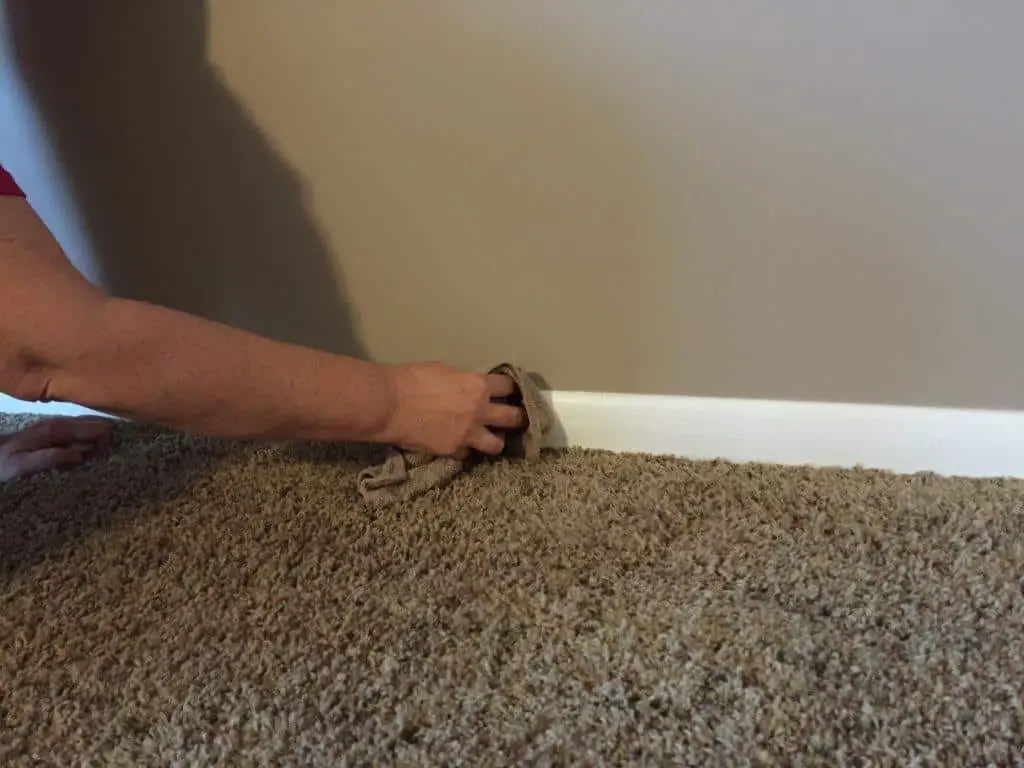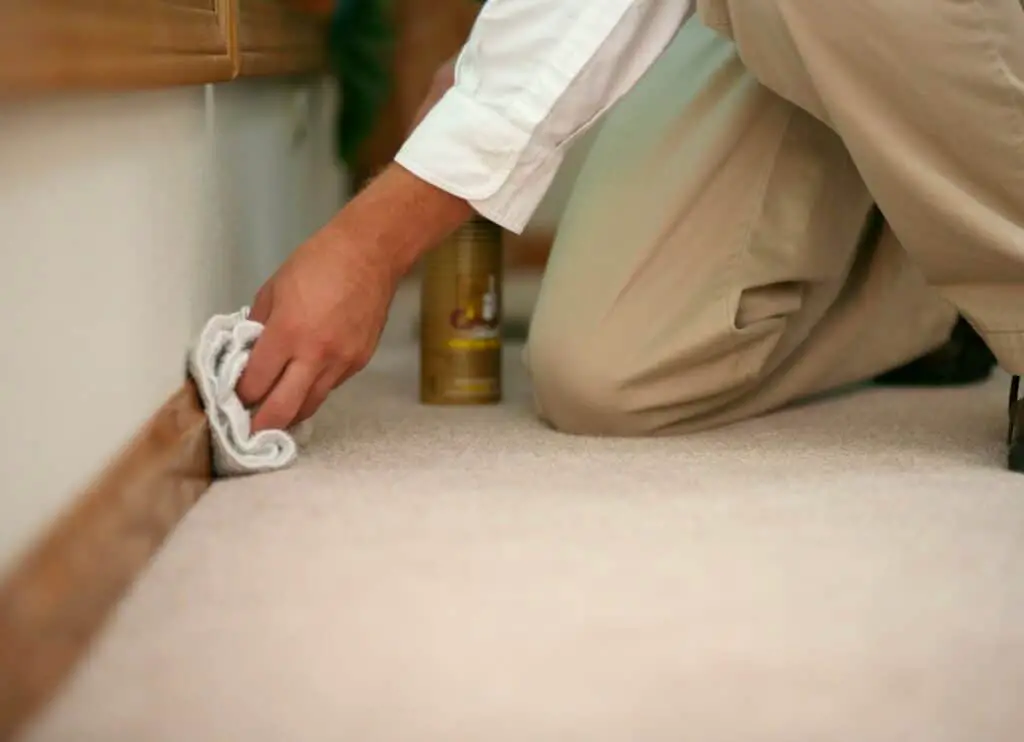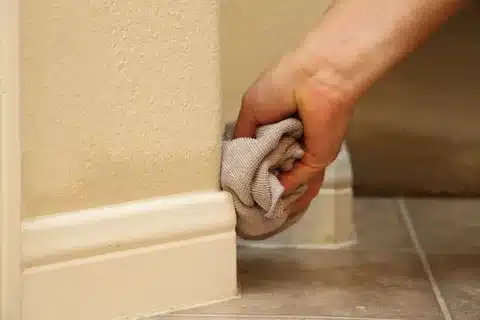What To Use To Clean Baseboards
Introduction
What To Use To Clean Baseboards: Baseboards are an essential part of any home’s interior design. They not only add a finishing touch to the overall look of a room but also protect the walls from scuffs and damage. However, over time, baseboards can accumulate dust, dirt, and grime, making them look dull and unappealing. Cleaning baseboards regularly is crucial to maintain their appearance and prolong their lifespan.
There are several methods and tools you can use to effectively clean baseboards, depending on the level of dirt and the material they are made of. In this article, we will explore different options and provide you with tips and tricks to make this task easier and more efficient.

What liquid cleaner for baseboards?
Mix a bucket of warm water, liquid dish soap and vinegar. Dip a sponge or soft cloth in the mixture and scrub scuffs and stains. A melamine sponge sold under the brand Mr. Clean Magic Eraser is a good choice for scrubbing tough grime.
One popular option for cleaning baseboards is a multi-purpose cleaner. These cleaners are designed to tackle a wide range of surfaces and can be used on baseboards as well. They are typically formulated to remove tough stains and dirt, making them an excellent choice for heavily soiled baseboards. However, it is important to read the label and follow the instructions carefully to ensure that the cleaner is safe to use on your specific type of baseboard material.
If you prefer a more natural approach, vinegar and water solution can be an effective cleaner for baseboards. Vinegar is known for its cleaning properties and can help remove dirt and grime from baseboards. Simply mix equal parts of vinegar and water in a spray bottle and spray the solution onto the baseboards. Let it sit for a few minutes, then wipe clean with a damp cloth. This method is safe to use on most types of baseboards and is an affordable and eco-friendly option.
For stubborn stains and grease, a degreaser can be a good choice. These cleaners are specifically formulated to break down grease and grime, making them ideal for kitchen baseboards or areas with heavy traffic. However, it is important to choose a degreaser that is safe to use on your specific type of baseboard material and to follow the instructions carefully to avoid any damage.
How do you clean dirty stained baseboards?
For stained wood baseboards, use a wood cleaner or gentle soap cleanser to remove dirt. You can also make a cleaner by mixing a few drops of vegetable oil and dish soap in a bowl of warm water. The soap cleans the baseboard while the oil leaves a leftover shine.
Dirty stained baseboards can be unsightly and can make a room look unkempt. However, with the right cleaning techniques, you can easily restore the cleanliness and beauty of your baseboards. Whether they are made of wood, vinyl, or another material, there are several methods you can use to effectively clean dirty stained baseboards.
Once you have your cleaning solution ready, dip a soft cloth or sponge into the solution and wring out any excess liquid. You don’t want the baseboards to become too wet, as this can cause damage. Gently wipe the baseboards with the damp cloth, working in small sections at a time.
If you encounter stubborn stains or grime, you may need to use a more abrasive cleaning method. For wood baseboards, you can try using a mixture of baking soda and water to create a paste. Apply the paste to the stained areas and gently scrub with a soft brush or toothbrush. For vinyl or painted baseboards, you can use a melamine foam eraser or a magic eraser to remove stubborn stains.
After cleaning the baseboards, use a clean, damp cloth to wipe away any residue or cleaning solution. Make sure to dry the baseboards thoroughly to prevent any water damage. You can use a dry cloth or a fan to speed up the drying process.
Can you clean baseboards with just water?
Every time you clean your home, you should dust the baseboards with a Microfiber Cloth or Duster. Dampen a microfiber cloth with just water for any debris that does not come off with the dry microfiber cloth or duster. Knowing how to clean baseboards takes only a few minutes and keeps them looking like new.
Yes, you can clean baseboards with just water. Baseboards are the horizontal boards that run along the bottom of walls, and they can accumulate dust, dirt, and grime over time. While there are many cleaning products available on the market specifically designed for baseboards, using just water can be an effective and eco-friendly alternative.
Water is a natural solvent that can help break down and remove dirt and grime from baseboards. It is also safe to use on most types of baseboard materials, such as wood, vinyl, or painted surfaces. Using water alone can be a cost-effective solution, as you don’t need to purchase any additional cleaning products.
Before cleaning your baseboards with water, it is important to prepare the area. Start by removing any loose dust or debris from the baseboards using a dry cloth or a vacuum cleaner with a brush attachment. This will help prevent scratching the surface of the baseboards during the cleaning process.
Once the loose dirt has been removed, dampen a clean cloth or sponge with water. Wring out any excess water to avoid saturating the baseboards. Gently wipe the damp cloth or sponge along the baseboards, working in small sections at a time. If there are stubborn stains or marks, you can apply a bit of gentle soap or a mild cleaning solution to the cloth or sponge.
Can you use baking soda to clean baseboards?
Mix baking soda with enough water to make a runny paste, and use a stiff-bristled brush to remove scuff marks, buildup, and stubborn stains. Use a damp cleaning cloth to wipe off the baking soda residue before moving on to the next stain.
Yes, baking soda can be used to clean baseboards effectively. Baking soda is a versatile household ingredient that has many cleaning properties. It is a mild abrasive that can help remove dirt, grime, and stains from various surfaces, including baseboards. Additionally, baking soda has natural deodorizing properties, which can help eliminate any unpleasant odors that may be lingering on your baseboards.
To clean baseboards with baking soda, you will need a few simple supplies. Firstly, gather a small bowl or container to mix the baking soda with water. You will also need a clean cloth or sponge and a bucket of warm water for rinsing. Optionally, you can add a few drops of your favorite essential oil to the mixture to leave a pleasant scent behind.
Start by mixing a paste using baking soda and water in the small bowl or container. The consistency should be thick enough to stick to the baseboards but still spreadable. Once the paste is ready, dip the cloth or sponge into the mixture and apply it to the baseboards. Use gentle circular motions to scrub away any dirt or stains. For stubborn stains, you can let the baking soda paste sit on the baseboards for a few minutes before scrubbing.
What is the fastest way to clean walls and baseboards?
Expensive to operate: Expect higher utility bills than with forced air through an HVAC system. Safety hazard: Electric baseboard heaters can get extremely hot. Without proper maintenance and care, they can become a fire hazard. To prevent fire, keep furniture and curtains at least six inches away.
When it comes to cleaning walls and baseboards, efficiency is key. Nobody wants to spend hours scrubbing away at stubborn stains or dirt. So, what is the fastest way to clean walls and baseboards? Let’s explore some effective techniques that can help you get the job done quickly and efficiently.
Dusting: Before diving into any deep cleaning, it’s important to start by removing loose dust and dirt from the walls and baseboards. This can be easily done by using a microfiber cloth or a duster. Simply wipe down the surfaces, making sure to reach all the nooks and crannies.
Magic erasers: For stubborn stains or scuff marks on walls and baseboards, magic erasers can be a lifesaver. These handy cleaning tools work like magic to remove marks without the need for harsh chemicals or excessive scrubbing. Simply dampen the eraser, gently rub the stain, and watch it disappear.
Vinegar solution: If you prefer a more natural approach to cleaning, a vinegar solution can be highly effective. Mix equal parts of white vinegar and water in a spray bottle, and lightly mist the walls and baseboards. Let the solution sit for a few minutes, then wipe it away with a clean cloth. Vinegar not only helps to remove dirt and grime but also acts as a disinfectant.
Are there any specific tools or equipment recommended for cleaning baseboards?
When it comes to cleaning baseboards, having the right tools and equipment can make the task much easier and more efficient. One essential tool is a microfiber cloth or sponge, which is gentle on the baseboards and helps to remove dust and dirt effectively. Microfiber cloths are also reusable and can be washed after use.
In addition to a microfiber cloth, a soft-bristle brush or an old toothbrush can be handy for cleaning hard-to-reach areas and crevices. These brushes can help loosen dirt and grime, making it easier to wipe them away. A vacuum cleaner with a brush attachment can also be useful for removing loose dirt and dust before wiping down the baseboards.
Are there any specific tools or equipment recommended for cleaning baseboards?
When it comes to cleaning baseboards, having the right tools and equipment can make the task much easier and more effective. Here are some specific tools and equipment that are recommended for cleaning baseboards:
Soft-bristle brush: A soft-bristle brush is ideal for removing dust and dirt from baseboards without causing any damage. It can easily reach into crevices and corners, ensuring a thorough clean.
Microfiber cloth: A microfiber cloth is great for wiping down baseboards after they have been brushed. It is highly absorbent and can effectively remove any remaining dirt or grime.
Vacuum cleaner with brush attachment: Using a vacuum cleaner with a brush attachment can be a quick and efficient way to remove loose dirt and dust from baseboards. The brush attachment helps to agitate the dirt, making it easier to vacuum up.
Mild detergent or cleaning solution: Depending on the level of dirt and grime on your baseboards, you may need to use a mild detergent or cleaning solution. Mix it with water according to the instructions and use a cloth or sponge to gently scrub the baseboards.
By using these specific tools and equipment, you can ensure that your baseboards are thoroughly cleaned and free from dirt and grime. Remember to always follow the manufacturer’s instructions and take proper safety precautions when using any cleaning products or equipment.
Can you provide step-by-step instructions on how to clean baseboards?
Prepare the area: Before you start cleaning, remove any furniture or obstacles near the baseboards to have easy access. Lay down a drop cloth or old towels to protect the floor from any drips or spills.
Dust the baseboards: Begin by dusting the baseboards using a microfiber cloth or a soft-bristle brush. This will help remove any loose dirt, dust, or pet hair. Make sure to reach into the corners and crevices.
Use a cleaning solution: Mix a solution of warm water and a mild detergent or a few drops of dish soap. Dip a sponge or a cloth into the solution and wring out any excess liquid. Alternatively, you can use a commercial baseboard cleaner.
Wipe the baseboards: Starting from one end, gently wipe the baseboards with the damp cloth or sponge. Use small circular motions to remove any stubborn stains or grime. Continue this process until you have cleaned all the baseboards in the room.
Dry and polish: After wiping the baseboards, use a dry cloth or towel to remove any excess moisture. This will prevent water damage and leave a polished finish. If desired, you can also apply a baseboard polish or wax for added shine and protection.
By following these step-by-step instructions, you can keep your baseboards looking clean and well-maintained. Remember to regularly clean your baseboards to prevent the buildup of dirt and dust, which can contribute to an overall cleaner and healthier living environment.
Are there any alternative methods or natural solutions for cleaning baseboards?
Yes, there are alternative methods and natural solutions that can be used to clean baseboards effectively. One popular natural solution is a mixture of vinegar and water. Simply mix equal parts of white vinegar and water in a spray bottle and spray it onto a microfiber cloth or sponge. Then, gently wipe down the baseboards, making sure to remove any dirt or grime. Vinegar is a natural disinfectant and can help remove stubborn stains.
Another alternative method is to use a mixture of baking soda and water. Create a paste by mixing baking soda with a small amount of water until it forms a thick consistency. Apply the paste to a cloth or sponge and scrub the baseboards, focusing on any areas with stains or buildup. The baking soda acts as a gentle abrasive and can help remove dirt and grime.
Are there any precautions or safety measures to consider when cleaning baseboards?
When cleaning baseboards, it is important to take certain precautions and safety measures to ensure a safe and effective cleaning process. Firstly, it is recommended to wear protective gloves to protect your hands from any chemicals or cleaning agents that may be used. Additionally, wearing safety goggles can help protect your eyes from any splashes or debris that may occur during the cleaning process.
Another important precaution to consider is to ensure proper ventilation in the area where you are cleaning the baseboards. This is especially important if you are using any strong cleaning agents that may emit fumes. Opening windows or using fans can help to circulate fresh air and prevent any respiratory issues.
Furthermore, it is crucial to read and follow the instructions provided on the cleaning products you are using. Some cleaning agents may require dilution or specific application methods, and failing to follow these instructions can result in ineffective cleaning or even damage to the baseboards. It is also important to test any new cleaning products on a small, inconspicuous area of the baseboards before applying them to the entire surface to ensure compatibility and prevent any potential damage.

Conclusion
Overall, when it comes to cleaning baseboards, there are several effective options to choose from. Whether you prefer a natural solution or a commercial cleaner, it is important to consider the type of baseboard material and the level of dirt and grime present.
If you are looking for a natural and cost-effective option, vinegar and water solution can be a great choice. This mixture not only helps to remove dirt and grime but also disinfects the baseboards. Additionally, using a microfiber cloth or a soft-bristle brush can help to gently scrub away any stubborn stains. However, it is important to avoid using excessive moisture, as this can damage certain types of baseboards.
On the other hand, if you prefer a commercial cleaner, there are numerous products available in the market specifically designed for cleaning baseboards. These cleaners often come in spray or wipe form, making them convenient to use. It is important to read the instructions and choose a cleaner that is suitable for your baseboard material. Additionally, wearing gloves and ensuring proper ventilation is recommended when using commercial cleaners.
keeping your baseboards clean not only enhances the overall appearance of your home but also helps to maintain their longevity. Whether you choose a natural solution like vinegar and water or opt for a commercial cleaner, it is important to regularly clean your baseboards to prevent the buildup of dirt and grime. By following the appropriate cleaning techniques and considering the type of baseboard material, you can ensure that your baseboards remain in pristine condition for years to come.
” Discover the best tools and products to effectively clean your baseboards. From brushes to microfiber cloths, find the perfect solution for a spotless and polished finish.








